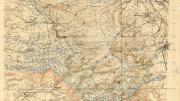Douglas Brockmeyer ’82 comes in exactly where more risk-averse people head for safety. At work, he thrives as a pediatric neurosurgeon operating on the delicate region where the spinal column attaches to the brain. In his spare time, he scales mountains.
Brockmeyer reached a longtime goal last spring when he summited Mount Everest. Facing a peak where even accomplished athletes have met their deaths, he did everything he could to minimize the danger. “I wouldn’t go to a place like Everest right off the street,” he explains. “I did it safely, by systematically stacking the odds in my favor. You do the same thing in surgery.”
Brockmeyer kept up a regular rock-climbing routine for 10 years before attempting Everest, building his strength and experience at sites near his home in Salt Lake City. On vacations, he visited more challenging regions, such as Alaska or Peru. “It was kind of a natural progression,” he says. “It would have been crazy not to [try Everest]. I had the experience. I was the right age and could take the time off and do it financially. If I hadn’t done it, I would have been thinking about it for the rest of my life.”
 |
| Holding prayer flags, Douglas Brockmeyer celebrates on top of Mount Everest. After 10 years of conditioning, two years of planning, and three months on location, he spent less than an hour at the summit. "For a few minutes, it's just sheer happiness and exuberance," he recalls. "But on the other hand, your body is saying, "Look, you've had a lot of fun, now you've got to get down, get out of here." He and fellow physician Geoffrey Tabin, M.D. '85, who reached the peak in 1988, belong to perhaps the most select Harvard club in the world. |
| Photograph courtesy Douglas Brockmeyer |
He arrived in Nepal with his guide, Dave Hahn, near the end of March. They went through weeks of climatization before settling in for the tedious wait at the Everest base camp until storms cleared long enough for a summit attempt. “By most accounts, it was one of the worst years ever,” Brockmeyer reports. His initial wait, at least, benefited from the presence of his bride, another avid climber. “We decided to honeymoon on the trek going up to base camp,” he says. “She loved it.”
But Debra Brockmeyersoon headed home, as did many other climbers when the end of May rolled around with no signs of clearing. Brockmeyer stayed, having learned the benefits of patience and planning the hard way when he was in college, during an ill-starred winter climb with friends from the Harvard Mountaineering Club.
Even so, there is always a certain amount of chance involved, he says, especially in a place like Everest. “The things that were a little bit scary were completely out of your control,” he explains, “like crossing ladders in the ice fall 30 or 40 feet across a really deep crevasse. You have to rely on the ladder, that it’s not going to fail.”
There was also the ever-changing weather. When Brockmeyer and Hahn received word that storms at the peak had momentarily cleared, they set out immediately, trekking over powdered snow because the trail had been obscured by the weeks of snow. On May 29 they reached Camp Four, the last camp before the summit. They took a quick nap and set out again at 10 p.m., hoping to reach the peak during the calm hours of the early morning. They climbed more than 3,000 feet through the night, using headlights to see and moving slowly because of the altitude and the cold. “It’s weird, climbing in the dark,” Brockmeyer says. “Your whole world is just this little 10 by 10-square-foot area that your headlamp is illuminating.” He was tired, but the excitement kept him going. Of the nearly 70 people who set out on a final summit push that night, he estimates that almost half turned back from exhaustion. He and Hahn kept to their plan: they stayed close to the front of the pack, directly behind the group that went ahead to lay down safety rope. This reduced the risk of losing valuable time by getting caught in a “bottleneck” the crowded and dangerous lines that form around narrow passes.
On May 30, at 9:30 p.m., they clambered onto a rectangular platform built by the Chinese and found about 20 people, most of them Sherpas, celebrating in the brilliant sunlight. They had reached the summit. “There were all these silk scarves and prayer flags,” Brockmeyer recalls. It was pretty wild, a beautiful day. We lucked out.”
~Elizabeth Widdicombe





